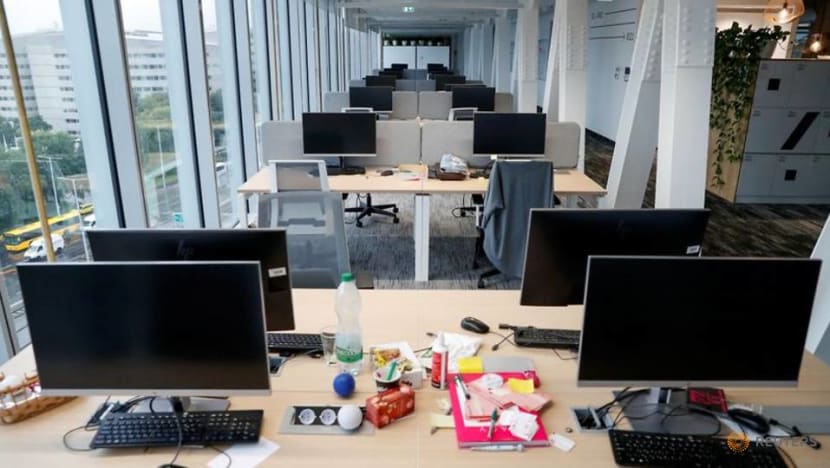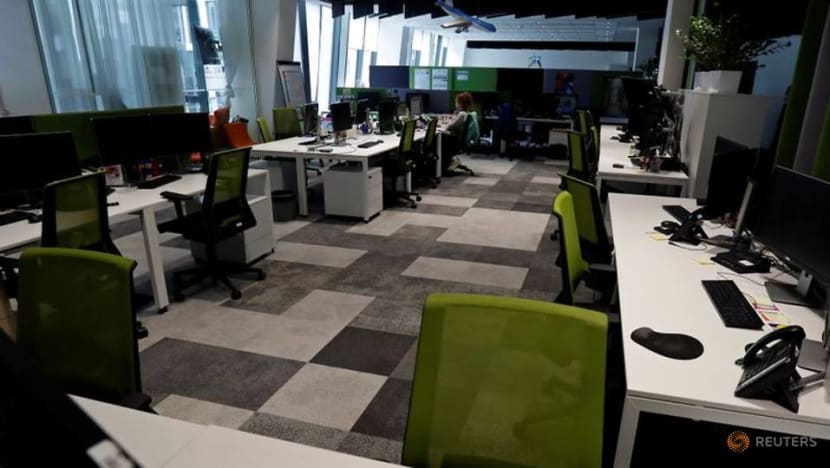commentary Commentary
Commentary: Relationships in the office have become superficial
Teams are no longer for life and it is breeding an emptiness that won’t be fixed once we’re back in the workplace, says the Financial Times' Pilita Clark.

An empty office is pictured at the Magyar Telekom HQ during the outbreak of the coronavirus disease (COVID-19), in Budapest, Hungary, October 12, 2020. (Photo: REUTERS/Bernadett Szabo)
LONDON: Every other week or so, a number emerges somewhere in the world that I find both understandable and troubling.
It is the percentage of people who consistently say they don’t want to go back to working full-time in the office.
Nearly 60 per cent of British workers said this was how they felt back in September last year and also in March this year, even though more than a third of the UK population had had at least one COVID-19 vaccine jab by then.
In the US, the share of workers who would prefer to keep working remotely as much as possible went from 35 per cent in September to 44 per cent in January.
More recent European research found 97 per cent of people who have been at home would prefer to stay there for at least part of the week once their offices reopen.
READ: Commentary: Why employers should cover WFH expenses
READ: Commentary: Hybrid working may change contractual terms and conditions for employees
Since I am one of the millions thrilled to be liberated from a rushed commute and the tedium of presenteeism, these findings seem utterly rational.
But they are also worrying because there is a gloomier reason that even well-paid, valued people in lofty jobs may be in no rush to go back to the office: Long before the outbreak, they were lonely.
SHALLOW RELATIONSHIPS
Their relationships with people in the office felt shallow. Worse, their sense of isolation may have had less to do with their personal lives than the way their work in teams was organised.
That is one finding from studies by Mark Mortensen, an associate professor of organisational behaviour at the Insead business school in France, and Constance Hadley, an organisational psychologist at Boston University’s Questrom School of Business.

Mortensen says they were taken aback after surveying hundreds of global executives just before the outbreak emptied offices around the world. Although the executives belonged to three teams on average, nearly 80 per cent said they struggled to connect with other team members and 58 per cent felt their social relationships at work were superficial.
The researchers say one reason is that teams have changed drastically since they began to replace traditional hierarchical work structures more than 30 years ago.
Earlier, one could expect to work in a team of a manageable size with the same group of people doing much the same thing for a relatively long time.
But as corporate work has gone more global and 24-hour, teams have been expected to be bigger, nimbler and more cost-effective.
READ: Commentary: It will be a waste if parents don’t keep flexible work arrangements
People join for briefer periods, depending on what skills are needed for a certain project, then flit off elsewhere. Or they share work with others in different time zones, so projects can be done around the clock, or work part-time on several teams at once.
GOOD FOR BUSINESSES, NOT SO GOOD FOR HUMANS
All this is good for an organisation’s flexibility and efficiency, but not so good for humans, who can struggle to name each member of their group.
“I do not know who is on my team,” one executive told the researchers. “Every Monday, somebody comes and tells me that he was assigned to something and the other guy who worked on that before just left.”
“I am interchangeable,” said another. “They have made it so anyone can do my job on the team. Maybe they would miss me, but I am not so sure.”
The pandemic has obviously fuelled a lack of camaraderie, but this research suggests putting everyone back in the office again won’t entirely fix the problem.
READ: Commentary: What if people don’t want to return to the office?

And hybrid working may exacerbate things, Mortensen told me last week, because people will be working on wildly different schedules.
“This is a problem that’s existed as long as there’s been shift work,” he said. “We’ve seen it in factories for the last 50 years or longer, but suddenly it’s something that we’re starting to see more of, thanks to hybrid working and flex time and these sorts of things, even in knowledge work.”
TACKLING LONELINESS
What can be done? Mortensen and Hadley say the first thing to do is assess whether loneliness exists.
If it does, think about creating core teams with a common mission that last years, not weeks.
Also, make sure team leaders understand workplace loneliness can be structural, not personal, so people won’t solve it on their own.
Finally, don’t expect it to disappear just because everyone has returned to the office.
Listen to EngageRocket CEO Leong Chee Tung and HR strategist Adrian Tan debate the merits of returning to the office on CNA's Heart of the Matter podcast:










